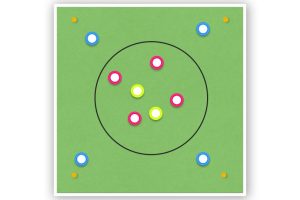How to Plan a Soccer Training Session
If you fail to plan, then you plan to fail. That’s something I like to think about when it comes to planning your soccer training sessions.
In this article, we’re going to go over all the elements you need to think about when planning training sessions.
Key Takeaways
- Recognizing issues in team play informs focused and effective training.
- Efficient session design maximizes resource use and keeps players engaged.
- Adaptability in planning caters to varying player numbers, maintaining productivity.
Make Sure You Train Your Game Model
Developing a consistent and pragmatic game model is vital for any soccer team’s success. This model shapes the squad’s tactical behavior and ensures all players are aligned with the coach’s strategic vision.
Defining Team Philosophy
Every soccer team operates under a set of core beliefs and values. Defining the team philosophy is about establishing what the team stands for and how they aspire to achieve their objectives.
This philosophy guides all decision-making on the pitch. For example, a coach may prioritize possession-based football, emphasizing technical skill and patience in building attacks.
Identifying Style of Play
The style of play is the practical application of the team philosophy in actual game scenarios. It determines whether the team favors a direct approach, utilizing speed and verticality, or a more composed, possession-oriented system.
The way a team controls the tempo, creates space, and recovers possession are all reflective of their chosen style, which should be consistently practiced to perfection.
Setting Tactical Objectives
Once the team philosophy and style of play are established, setting clear tactical objectives is the next step.
These objectives provide measurable goals, such as maintaining a specific pass completion rate, achieving a set number of successful dribbles, or limiting the opposition’s shots on target.
It is essential that these objectives are tailored to the team’s strength and the opponents they face, allowing them to adapt and apply pressure effectively.
Recognizing Football Problems
Before developing a soccer training session, coaches need to clearly identify what issues the team is facing. This involves looking at previous games, evaluating players, and pinpointing specific weaknesses within the team.
Analyzing Recent Matches
Coaches should meticulously review game footage, taking note of recurring mistakes or patterns that led to unsuccessful plays. They should also examine both individual and team movements during key moments of the match.
They may create a table listing the types of errors, frequency, and the match situations in which they occurred. This approach ensures a data-driven strategy to problem-solving.
For example, if your team’s press was broken constantly during the last game, you might want to plan a session on pressing.
Assessing Player Performance
A thorough assessment of each player’s skills and contributions during the matches helps identify areas for improvement.
Coaches should look at aspects such as passing accuracy, decision-making under pressure, and positional awareness. A bulleted list can help to:
- Track individual player metrics
- Highlight specific training needs
- Encourage personalized development plans
Addressing Team Weaknesses
Once the individual assessments are complete, coaches then focus on the collective weaknesses of the team. These could be anything from a lack of cohesion in defense to inefficiency in converting scoring opportunities.
Solutions may involve tactical adjustments or specific drills that replicate challenging scenarios the team has faced. This subsection is supported by practical advice from structuring a training session that builds on the identified weaknesses.
Designing the Training Session
Effective training sessions are the cornerstone of any soccer team’s success. They specifically address the team’s tactical needs and help each player develop the necessary skills. Below are essential considerations when designing a soccer training session.
Creating a Session Plan
Coaches should first identify their team’s game model and pinpoint soccer problems from previous matches.
A session plan acts as the blueprint for practice, aligning each activity’s objectives with the team’s ultimate goals. For instance, if a team struggles with maintaining possession, the plan might focus on improving players’ comfort on the ball under pressure.
Selecting Drills and Activities
Drills should progress from simple to complex, catering to the varying levels of player skill and understanding.
It’s essential to adopt drills that simulate real-game scenarios, providing players with context and practical application.
If a training session’s goal is to improve shooting, activities could range from unopposed finishing drills to small-sided games focusing on creating and taking shooting opportunities.
Incorporating Skill Development
Skill development must be tightly interwoven with the tactical and physical aspects of the game. This requires drills that encourage players to use specific skills repeatedly in different contexts.
If dribbling is the focal skill, a coach might start with exercises involving dribbling through cones before progressing to 1v1 situations.
Adaptability is key; sessions should be designed to accommodate unexpected changes in player numbers without losing their effectiveness.
Organizing Session Logistics
When planning a soccer training session, logistics form the backbone of its effectiveness. Properly preparing equipment and space and managing time efficiently are crucial steps a coach must consider.
Preparing Equipment and Space
Before players set foot on the pitch, a coach must ensure that the training area is properly set up. They should have a clear understanding of their game model and the specific drills that will be executed during the session.
For equipment preparation, one should:
- Cones: Place these to mark boundaries and drill stations.
- Goals: Set up mini-goals or full-size goals depending on drills.
- Balls: Have more than enough for each player to minimize downtime.
- Bibs: Prepare different colored bibs for drill differentiation.
The space should be checked for safety hazards and be appropriate for the number of participants. They might have to adjust the dimensions of the playing area based on the exercises they are planning to conduct.
Managing Time Efficiently
Effective time management is paramount. A coach should allocate specific time slots for each segment of the session:
- Warm-up (10-15 minutes): Gradual increase in intensity.
- Main Drills (20-30 minutes each): Focus on football problems identified.
- Cool-down (10 minutes): Lower intensity, begin recovery.
Additionally, they should build buffer times between activities to account for transitions and unexpected delays. Keeping sessions flexible is key, as sometimes they may need to adapt to variable player numbers.
A coach must also be conscious of recovery periods to prevent overtraining and injuries.
Adapting to Player Availability

Successful soccer training sessions account for the fluctuating number of players that can attend. Coaches must be adept at modifying drills and ensuring all participants are engaged regardless of group size.
Modifying Drills for Different Group Sizes
Small Groups: When faced with a smaller group, coaches can tailor drills to focus on technical skills or tactical understanding.
A drill originally planned for larger groups can be adjusted to smaller, triangle passing exercises that improve quick decision-making and close control. For inspiration on adapting to numbers, reference sessions that deal with changing locations and conditions that inherently require flexibility.
Larger Groups: Conversely, with more players, one can set up multiple stations to run the same drill simultaneously or organize larger small-sided games.
For instance, transitioning from a 3v3 to a 6v6 format can maintain the intensity and mimic real-game scenarios more closely.
Utilizing approaches that make sessions appropriate may include more scrimmage-based activities where each player has a specific role mirroring their potential in-game position.
Ensuring Engagement and Inclusivity
Variability is Key: Engagement hinges on every player feeling included and challenged.
Coaches can introduce variability within drills, where every player gets an equal opportunity regardless of their skill level. Simple adjustments like mixing player pairings or setting individual challenges within a team drill can spur inclusivity.
Tailor to Abilities: Differentiating the skill requirement within drills ensures all players can participate meaningfully.
For those needing more challenge, increasing the complexity of the task or adding a competitive element keeps them engaged. Tailoring elements to align with the youth soccer environment can be extremely beneficial for maintaining high levels of participation and progression.
Implementing the Training Plan
When bringing a soccer training session to life, coaches must focus on the dynamics of executing drills, pinpointing and communicating coaching points, and making real-time adjustments. These elements are pivotal for an effective session that resonates with players and translates into the game.
Executing Drills Effectively
Coaches should set up drills before players arrive, ensuring no time is wasted.
Each drill should reflect an aspect of the game model and be directly linked to the football problems identified.
It is essential to explain drills succinctly to players, making the purpose clear. All exercises should be realistic to the game and provide a challenge that is appropriate to the skill level of the players.
Providing Coaching Points
A critical part of any training session is integrating clear, concise coaching points. They guide players to recognize and solve football problems effectively.
Coaches should observe and offer targeted feedback, focusing on the session’s objectives. It’s beneficial to acknowledge correct actions and provide individualized feedback when necessary to foster player development.
Making In-Session Adjustments
A coach must be prepared to adapt the session based on various factors, such as changes in player numbers or unforeseen disruptions.
They could apply a whole-part-whole structure when needed. This structure starts with a game to introduce the session’s theme, then breaks it down to work on specific parts, and finally returns to the game to apply what’s been learned.
Flexibility is key, and adjustments should always serve the session’s primary goals.
Reviewing and Reflecting

After a soccer training session, it is crucial for a coach to analyze the effectiveness of the session and use the insights to enhance future planning.
Evaluating Session Outcomes
A coach should assess whether the session met its objectives by examining both qualitative and quantitative data.
She might ask, “Did the players improve their passing accuracy?” or, “How has the team’s understanding of the game model progressed?”
Reflection on the session’s structure, such as The Simple To Complex Structure, can provide insights into what worked and what didn’t.
Gathering Player Feedback
Player feedback is vital. A coach may collect it through anonymous questionnaires or by fostering an environment where players feel comfortable voicing their opinions directly.
They might consider questions like, “How do you feel about the drills we did today?” Feedback helps in understanding the players’ perspective and tailoring sessions more effectively.
Planning for Future Sessions
With the information gathered, coaches plan future sessions that build on strengths and address weaknesses.
They make adjustments for player numbers and modify drills to match the team’s evolving needs. Monitoring player progression over time allows the coach to adapt the training schedule, acknowledging concepts from resources like Player Development Project, to accommodate the individual and the group.
Frequently Asked Questions
In this section, coaches will find answers to some of the most crucial questions regarding soccer training sessions. These insights focus on establishing a solid game model, addressing team challenges, and ensuring that every practice is time-efficient and adaptable.
What fundamental principles should I consider when designing my football game model for training?
When constructing a football game model for training, coaches should emphasize progressiveness and relevance to match scenarios. A structured approach that starts with simple practices and progresses to more complex ones ensures players grasp basic concepts before moving on to advanced tactics.
Can you suggest ways to identify and address common football problems during practice sessions?
One effective method to diagnose and tackle football problems is through continuous observation and feedback during soccer practice sessions. Tailoring drills to target these issues directly can lead to swift improvement in specific areas of the players’ game.
What are the key components of an efficient football training session setup?
An efficient training session setup should maximize active participation with minimal downtime.
This involves preparing drills in advance, using clear instructions, and ensuring that the equipment is ready before players arrive.
How can I modify soccer drills to accommodate varying numbers of players?
To accommodate different player numbers, coaches should design drills that are scalable and flexible.
For larger groups, consider using stations or rotating players through multiple activities to maintain high engagement. For smaller groups, adapt drills to focus on individual skills or smaller-sided games.
What are the best practices for structuring a soccer training session to optimize team performance?
The best practices for structuring a soccer training session include using a mix of technical, tactical, physical, and psychological elements to provide a holistic approach to player development.
Starting with a warm-up and progressing through phases of play as if simulating parts of a real game can be highly effective.
What tactics can I employ to ensure that training remains engaging and productive for all players?
To keep training engaging and productive, include a variety of drills. Also, foster a competitive yet supportive atmosphere. Make sure each session includes elements of play that promote creativity and enjoyment.
Emphasizing the fun aspect of the game will keep players motivated and focused during the session.






